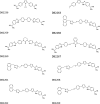Phenotypic Screening In Vitro of Novel Aromatic Amidines against Trypanosoma cruzi
- PMID: 27216059
- PMCID: PMC4958229
- DOI: 10.1128/AAC.01788-15
Phenotypic Screening In Vitro of Novel Aromatic Amidines against Trypanosoma cruzi
Abstract
The current treatment of Chagas disease (CD), based on nifurtimox and benznidazole (Bz), is unsatisfactory. In this context, we performed the phenotypic in vitro screening of novel mono- and diamidines and drug interaction assays with selected compounds. Ten novel amidines were tested for their activities against bloodstream trypomastigote (BT) and amastigote forms of Trypanosoma cruzi (Y and Tulahuen strains) and their toxicities for mammalian host cells (L929 cells and cardiac cells). Seven of 10 molecules were more active than Bz against BT, with the most active compound being the diamidine DB2267 (50% effective concentration [EC50] = 0.23 μM; selectivity index = 417), which was 28-fold more active and about 3 times more selective than the standard drug. Five of the six monoamidines were also more active than Bz. The combination of DB2267 and DB2236 in fixed-ratio proportions showed an additive effect (sum of fractional inhibitory concentrations < 4) on BT. Interestingly, when intracellular forms were exposed to DB2267, its activity was dependent on the parasite strain, being effective (EC50 = 0.87 ± 0.05 μM) against a discrete typing unit (DTU) II strain (strain Y) but not against a representative DTU VI strain (strain Tulahuen) even when different vehicles (β-cyclodextrin and dimethyl sulfoxide) were used. The intrinsic fluorescence of several diamidines allowed their uptake to be studied. Testing of the uptake of DB2236 (inactive) and DB2267 (active) by amastigotes of the Y strain showed that the two compounds were localized intracellularly in different compartments: DB2236 in the cytoplasm and DB2267 in the nucleus. Our present data encourage further studies regarding the activities of amidines and provide information which will help with the identification of novel agents for the treatment of CD.
Copyright © 2016, American Society for Microbiology. All Rights Reserved.
Figures




Similar articles
-
Repurposing Strategy of Atorvastatin against Trypanosoma cruzi: In Vitro Monotherapy and Combined Therapy with Benznidazole Exhibit Synergistic Trypanocidal Activity.Antimicrob Agents Chemother. 2018 Aug 27;62(9):e00979-18. doi: 10.1128/AAC.00979-18. Print 2018 Sep. Antimicrob Agents Chemother. 2018. PMID: 29987140 Free PMC article.
-
In Vitro and In Vivo Trypanosomicidal Action of Novel Arylimidamides against Trypanosoma cruzi.Antimicrob Agents Chemother. 2016 Mar 25;60(4):2425-34. doi: 10.1128/AAC.01667-15. Print 2016 Apr. Antimicrob Agents Chemother. 2016. PMID: 26856830 Free PMC article.
-
In vitro investigation of the efficacy of novel diamidines against Trypanosoma cruzi.Parasitology. 2014 Sep;141(10):1272-6. doi: 10.1017/S0031182014000407. Epub 2014 Apr 15. Parasitology. 2014. PMID: 24735493
-
In Vitro, In Silico, and In Vivo Analyses of Novel Aromatic Amidines against Trypanosoma cruzi.Antimicrob Agents Chemother. 2018 Jan 25;62(2):e02205-17. doi: 10.1128/AAC.02205-17. Print 2018 Feb. Antimicrob Agents Chemother. 2018. PMID: 29203486 Free PMC article.
-
Experimental models in Chagas disease: a review of the methodologies applied for screening compounds against Trypanosoma cruzi.Parasitol Res. 2018 Nov;117(11):3367-3380. doi: 10.1007/s00436-018-6084-3. Epub 2018 Sep 19. Parasitol Res. 2018. PMID: 30232605 Review.
Cited by
-
TrypanocidalActivity of Natural Sesquiterpenoids Involves Mitochondrial Dysfunction, ROS Production and Autophagic Phenotype in Trypanosomacruzi.Molecules. 2018 Oct 28;23(11):2800. doi: 10.3390/molecules23112800. Molecules. 2018. PMID: 30373326 Free PMC article.
-
Combination With Tomatidine Improves the Potency of Posaconazole Against Trypanosoma cruzi.Front Cell Infect Microbiol. 2021 Mar 4;11:617917. doi: 10.3389/fcimb.2021.617917. eCollection 2021. Front Cell Infect Microbiol. 2021. PMID: 33747979 Free PMC article.
-
Chagas Disease: Detection of Trypanosoma cruzi by a New, High-Specific Real Time PCR.J Clin Med. 2020 May 18;9(5):1517. doi: 10.3390/jcm9051517. J Clin Med. 2020. PMID: 32443464 Free PMC article.
-
Differential Effects of Two Widely Used Solvents, DMSO and Ethanol, on the Growth and Recovery of Trypanosoma cruzi Epimastigotes in Culture.Korean J Parasitol. 2017 Feb;55(1):81-84. doi: 10.3347/kjp.2017.55.1.81. Epub 2017 Feb 28. Korean J Parasitol. 2017. PMID: 28285511 Free PMC article.
-
Synergistic effect and ultrastructural changes in Trypanosoma cruzi caused by isoobtusilactone A in short exposure of time.PLoS One. 2021 Jan 28;16(1):e0245882. doi: 10.1371/journal.pone.0245882. eCollection 2021. PLoS One. 2021. PMID: 33507972 Free PMC article.
References
-
- World Health Organization. 2015. Chagas disease. World Health Organization, Geneva, Switzerland: http://www.who.int/topics/chagas_disease/en/.
-
- Chagas CJ. 1909. Nova tripanosomíase humana: estudos sobre a morfologia e o ciclo evolutivo do Schizotrypanum cruzi, n. gen., n. sp., agente etiológico de nova entidade mórbida do homem. Mem Inst Oswaldo Cruz 1:159–218.
-
- Coura JR, Dias JCP. 2009. Epidemiology, control and surveillance of Chagas disease—100 years after its discovery. Mem Inst Oswaldo Cruz 104:31–40. - PubMed
Publication types
MeSH terms
Substances
Grants and funding
LinkOut - more resources
Full Text Sources
Other Literature Sources

